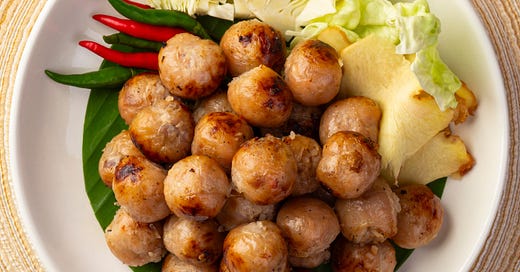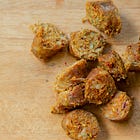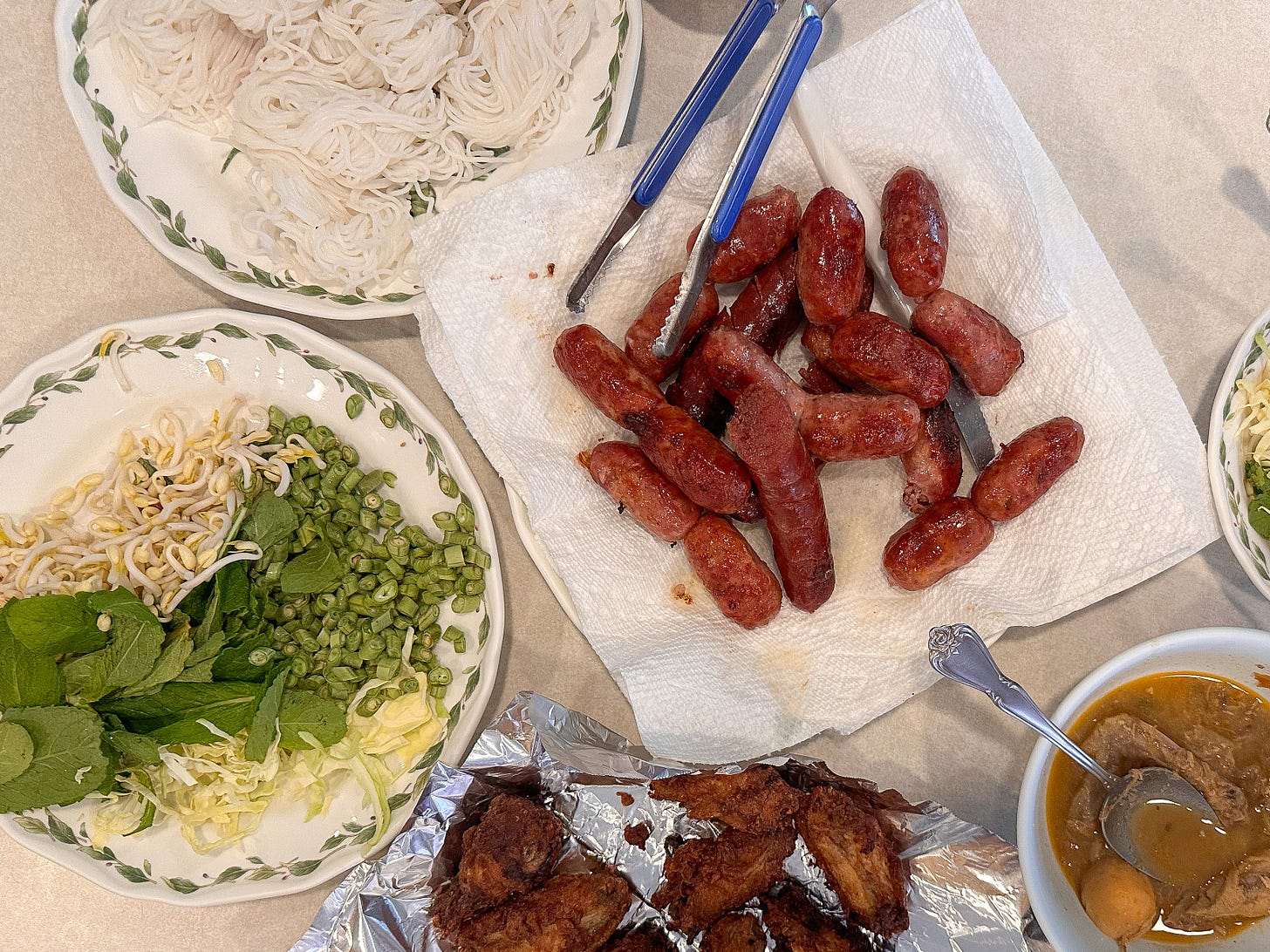Hello and happy Friday! Long time no see, I can hardly believe it’s been an entire month since my last newsletter. Between freelancing, traveling, classes, and other hobbies keeping me busy, time has absolutely been flying. In between all the things, I’m cooking, researching, and recipe developing which has been feeding my soul. It’s nice to be able to slow down and sit with my thoughts, and I’m excited to share everything I know about my latest Thai Sausage obsession.
Last time, I kicked off this Thai sausage series with Sai Ua, the herby, curry-paste-stuffed coil from Northern Thailand. Today, I’m taking things to the Northeastern region with a sausage that’s arguably just as iconic but built on a very different flavor philosophy. If you’re here and just joining me, check out my last newsletter on Sai Ua.
But before we dive in, a quick housekeeping update! I’ll be participating in a Thai Takeover community event next week at MoFAD in Brooklyn on May 29th for AANHPI Month, where I’ll be debuting my Laab Pockets to the public for the first time! This event is a happy hour celebrating Thai creatives, restaurants, and brands in the food and beverage world, featuring bites, demos, sips, and more. You can grab your ticket here—come say hi and come hungry.
Now without further ado, let’s get into the topic at hand: Sai Krok Isaan (ไส้กรอกอีสาน).
What is Sai Krok Isaan ไส้กรอกอีสาน?
Sai Krok Isaan is a pork sausage that’s been fermented with sticky rice. It’s tangy, a little silky, definitely funky, and incredibly snackable. Its roots are in the Isaan region, a rural area in the Northeastern part of Thailand that borders Laos and Cambodia. This region is my favorite from a culinary perspective; the food is heavenly and all of my favorite dishes come from this region (laab, som tum, all kinds of grilled meats). Sai Krok Isaan fits right into that lineup, with its unique fermented tang, savory depth, and a crisp outer snap when grilled.
Historically, the sausage’s roots go deep. Fermented sausages in this region trace back hundreds of years and are deeply tied to Lao culinary traditions. Isaan and Laos share more than just a border. They share ingredients, preservation techniques, and food philosophies that continue to shape the cuisine today. In fact, a lot of my grandma’s home cooking includes a lot of Lao cuisine or Lao-influenced Thai cuisine. I can’t help but wonder if that’s why I’m so drawn to the flavors of Isaan!
You can find Sai Krok Isaan sizzling on skewers at street stalls across Thailand, often served with sticky rice, raw cabbage, bird’s eye chilies, and sometimes even slivers of fresh ginger. It’s the kind of food that invites you to eat with your hands, to snack, to share, to chase every bite with a crunchy veg or chili. My favorite combo is to bite into the sausage, then bite into a toasted Thai chili, and then nibble on a little lime wedge to make it even more sour. I’m salivating just thinking about it.
What makes Sai Krok Isaan so delicious?
One word: fermentation.
These sausages are made with a mixture of ground pork, cooked sticky rice, garlic, salt, and sugar, and then left to ferment at room temperature for a day or two (or longer, depending on how funky you like it). The rice kicks off the fermentation process, which then creates that signature tangy-sour flavor that sets Sai Krok Isaan apart from other sausages.
If you’re new to fermented meat, don’t panic! It’s a safe and controlled sourness, and it’s what gives the sausage its addictive bite. The tanginess is what makes it special and it’s one of the few that relies more on fermentation than spice for its flavor, which also makes it an exciting entry point into the world of funky Southeast Asian preserved meats. If you’re used to rich, fatty sausages, this is a completely different experience.
How is it made?
Unlike Sai Ua, which gets its flavor from herbs and curry paste, Sai Krok Isaan gets its complexity from that short and magical fermentation process we talked about. The fermentation develops a gentle sourness, while the rice keeps the texture tender and helps the sausage hold together.
I’m obviously not a food scientist, but here’s where it gets a little food science-y. It was definitely an interesting rabbit hole to fall down, but I’ll keep it simple! Cooked sticky rice (glutinous rice) is rich in starch, and when you mix it with ground pork, garlic, and salt, lactic acid bacteria (which is already present on the rice, in the environment, and in the garlic) begin to break down those starches into sugars.
Those sugars become food for the bacteria, which gets the lactic acid fermentation going. As the bacteria feeds, it produces more lactic acid, which:
Lowers the pH of the sausage mixture (making it more acidic)
Creates its signature tangy sour flavor
Acts as a preservative, keeping the sausage safe during its short fermentation window.
Where to Buy Sai Krok Isaan
If you’re in NYC, you’re in luck: I’ve found Sai Krok Isaan pretty easily at local Thai markets, usually in the frozen section right alongside Sai Ua.
You’ll also spot it on menus at several Thai restaurants across the city. In the name of research (of course), I visited a few to see how they serve it, and no two versions were exactly alike. Some, like Zaab Zaab, serve theirs in traditional linked rounds. Others, like Somtum Der, opt for short sausage links, which are then cut into bite-sized pieces that are perfect for sharing.


These different shapes aren’t just aesthetic choices, they influence how the sausage is cooked, portioned, and served. The traditional linked rounds make for easy snacking, while the short links are great for uniform stuffing and simple slicing. If you’re in NYC and curious about Sai Krok Isaan, both spots are worth a visit!
I could ramble even longer, but to spare your inbox from getting cut off, I think that’s a wrap on Sai Krok Isaan. Next up in the Thai sausage series is another fermented friend—Naem. Stay tuned 👀









Ooh they look incredible! Have you tried making your own sai krok yet?
A friend brought us back some fermented nem chua sausages from Vietnam and they were absolutely delicious.
We do a lot of vegetable ferments, but haven't given meats a whirl yet.
Gimme dat